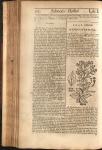


 This chapter hasn't been proofread yet.
This chapter hasn't been proofread yet.
l. The Names. It is called in Greek, *Αλλ,* A We*: In Latin, AlJ9le Aquatica : And in Englijh, Water Onckweed.
II. The Kinds. It is fivefold, 1. Alfine aquatica major. The greater Water Chickweed. 2. Alfine aauatica minor, The lesser Watet Ch ickweed. 3. Alfine aquatica minima, & ferpillijolia Bauhini, The smalleft Water Chickweed. 4. *Aa™» Θλαλγοτ*, Al-fine marina, Sea Chickweed : Lobel calls it, Hip-pia major; and Cafalpinm, Centunculus. 5. Alfine retla, flore Cstruleo, Upright blew Chickweed. There is anothei which fome account a Sea Chick-weed, viz. Alfine Palufirss minor folio oblongo, which others more properly call, Portulaca marina, Sea Purflain, and under that Title you will find it.
Chktwcer
III. The Descriptions. The firfi of these has a creeping Root, filming out with divers Fibres, very long, and of the thicknefs of a Wheat Straw, not much unlike to the Roots of Quitch-grafs, from whence rife up divers upright Stalks, flender, and jointed from the bottom to the top, set with pretty large Jharp pointed Leaves, standing by pairs at certain diftances, somewhat like those of Pellitory of the Wall. At the tops of the Stalks grow small white Flowers, like to the other Chickweeds, or like to Stitchwort, lejfer,having many small asid pointed Leaves in each Flower^ after winch come
fmall
whitijh yellow Seed. \ .
IV. The second of these has a bunchy fibrous Root, from whence several weak and tender Stalks rije up, jomted like the former, and with Leaves at the Joints, as in the other, not much unlike ist jhape
and
and bignefs to the Letter Chickweed, in the former Chapter. The Stalks rife up sometimes to be a yard high, full of Branches, and small long Leaves on them, of a pale green Color. 'Lhe Flowers are many, which at the tops of the Branches are small and white, confifting of five Leaves apiece ; after which follows in Husks small yellowifh beed.-
Smaller rf/tf
Smahst /wafer CiicA weed,
up many weak and tender creeping Branches, Jet with two narrow sharp pointed Leaves at each Joint, green above, and of a whitifh color below ; at the set ting on of these Leaves grow small Vejfels parted ok it were into two, with a little craft on each side, in which Cap Jul £ are contained very small Seed.
VI. The fourth, or Alfine marina, has a bunchy and thready Root a* fome of the former, which fends forth for the moft part Branches lying upon the ground, very, like unto the lesser sort of Chickweed in the former Chapter, but that the Stalks are jliorter, and thicker, anadefer Jointed, with Chickweed like Leaves on them, yet thicker, and whiter : The Flowers also ft and at the tops of the Branches, and are compofed of many small Leaves in form of a Star which being past away, the Seed Vessels follow, which are long and round like the others, but fiat, and somewhat broad, in which are contained three or Jour greater Seeds.
fea cinch meed.
The third, or smallefl kind, Serpillifoliis, ha, a small Root, with many fibres, from whence fpring
VII. Tl?e fifth has a Root white and long, with fome fibres thereat, from whence rife up for the mo β part several upright Stalks or Branches, jointed in feve* ral places, and divers small Leaves growing ihere* on at the manifold Joints, somewhat divided like unto Leaves of Rue, and a little refembling a Trefoil Leaf: at the tops of the Joints come forth small blew Flowers, confifting of four Leaves apiece: which being past away, there appears small round Chick-weed like Heads or Husks, with small Seed therein.
VIII. The Places. The firfi threey and the fifth, are found to grow in or pear Waters, and Watry places in molt Parts of England. The Serpilhfolia may be found in Watry places, between Clapham Heath and Touting, and between Kent/fir Town and Hamflead. And the fourth grows near rhe Sea ihore, and in Salt Alarfiy places, upon federal Coafts of this Kingdom.
IX. Tlie Times. Their flowering time is in th& heat of Summer, and their Seed ripens in the mean Seafon^and in a little time after.
X. The Qualities, Spec'ification, Preparations and
Virtues, are the fame with those in tbe former
Chapter, to which we reier vou.
Botanologia, or The English Herbal, was written by William Salmon, M.D., in 1710.

 Page 216
Page 216 Page 217
Page 217